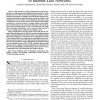Free Online Productivity Tools
i2Speak
i2Symbol
i2OCR
iTex2Img
iWeb2Print
iWeb2Shot
i2Type
iPdf2Split
iPdf2Merge
i2Bopomofo
i2Arabic
i2Style
i2Image
i2PDF
iLatex2Rtf
Sci2ools
JSAC
2006
2006
Performance Preserving Topological Downscaling of Internet-Like Networks
Abstract--The Internet is a large, heterogeneous system operating at very high speeds and consisting of a large number of users. Researchers use a suite of tools and techniques in order to understand the performance of complex networks like the Internet: measurements, simulations, and deployments on small to medium-scale testbeds. This work considers a novel addition to this suite: a class of methods to scale down the topology of the Internet that enables researchers to create and observe a smaller replica, and extrapolate its performance to the expected performance of the larger Internet. This is complementary to the work of Psounis et al., 2003, where the authors presented a way to scale down the Internet in time, by creating a slower replica of the original system. The key insight that we leverage in this work is that only the congested links along the path of each flow introduce sizable queueing delays and dependencies among flows. Hence, one might hope that the network properties ...
Congested Links | Internet | JSAC 2006 | Performance |
| Added | 13 Dec 2010 |
| Updated | 13 Dec 2010 |
| Type | Journal |
| Year | 2006 |
| Where | JSAC |
| Authors | Fragkiskos Papadopoulos, Konstantinos Psounis, Ramesh Govindan |
Comments (0)

